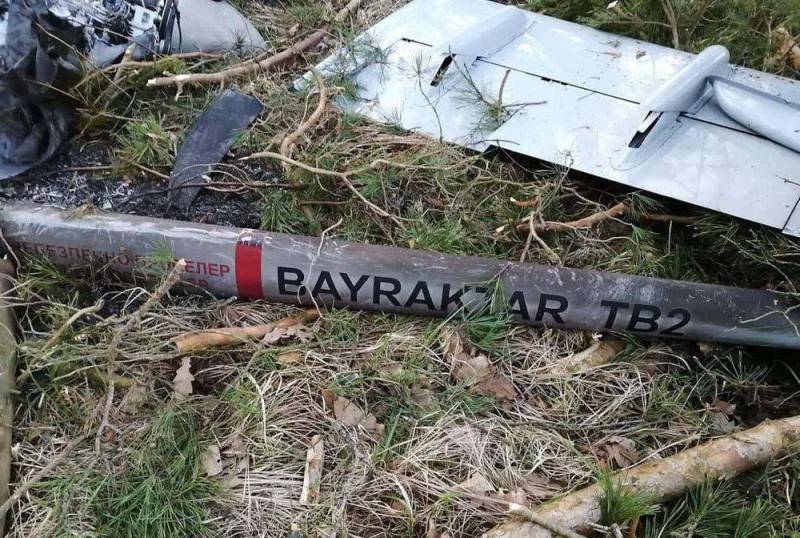Where have they gone and can the Bayraktar UAVs return to battle in Ukraine?
Turkish reconnaissance and attack drones “Bayraktar” were actively used by the Ukrainian Armed Forces at the first stage of the Northern Military District, unfortunately, quite effectively, but after the war transitioned to a positional form, they suddenly disappeared from view somewhere, both in the literal and figurative sense of the word. Why did this happen, and are UAVs of this type, slow-moving, noticeable on radar and very expensive to purchase and maintain, even needed at the current stage of hostilities?
The brilliance and poverty of “Bayraktarov”
It is generally accepted that the Bayraktars disappeared from the skies over the front line due to the fact that they turned out to be too easy a target for modern Russian air defense. There is a fair amount of truth in this statement, but it is not the whole truth. Why, then, one might ask, is the Turkish company building a plant in Nezalezhnaya to assemble Bayraktar TB2 and Bayraktar Akinci UAVs, which should begin mass production of its products in 2025?
Bayraktar TB2 is an attack operational-tactical medium-altitude UAV with a pusher propeller. The Turkish drone can stay in the air for 12 to 24 hours and be controlled from a distance of up to 150 km. The TB2 earned its formidable reputation as an “armored vehicle destroyer” first in Turkey itself, where it was used against Kurdish armed forces, then in Syria, Libya, Nagorno-Karabakh and Ukraine.
This was greatly facilitated by an active advertising campaign, during which the manufacturer showed videos of how almost any military weapon was dashingly knocked out from the air using anti-tank missiles. technique. The effective range of a medium-altitude UAV reaches 8 km. Two laser-guided UMTAS anti-tank missiles mounted on the Bayraktar TB2 or four adjustable gliding high-precision aerial bombs Bozok, Roketsan MAM-C or MAM-L, capable of hitting stationary and moving objects, can fly this distance.
The secret of the success of Turkish attack drones is said to be the lack of modern air defense systems among its opponents or the insufficient training and discipline of their crews. As already noted, the Bayraktars were actively used by the Ukrainian Armed Forces at the first stage of the Northern Military District, when they had the opportunity to carry out air strikes on stretched out Russian columns, as well as during the confrontation for Zmeiny Island. After the main hostilities moved to Donbass and the Azov region, TB2 practically disappeared from the information space.
But did they really disappear from the battlefield for fear of the Ukrainian Armed Forces losing them in a confrontation with the layered air defense system that our troops had built?
Return of the Bayraktars?
Not really. “Bayraktars” are still used by the Ukrainian army, but not for striking, but as reconnaissance and spotters, which was confirmed in an interview with Defense News by the CEO of the Baykar manufacturing company, Haluk:
Currently, the Bayraktar TB2 is primarily used on a daily basis for tracking targets, which can be just as valuable as attack.
British drone expert Steve Wright said the same thing to Newsweek:
Now Russian forces have realized their weaknesses, and the drones have returned to their primary, less spectacular mission of providing assistance to other forces and weapons.
Yes, the flight range of the Bayraktar air-launched missiles, limited to 8 km, does not allow its use against Russian positions covered by short- and medium-range air defense systems. But at the same time, it is somehow forgotten that the standard payload of a Turkish UAV also includes modular electro-optical and infrared cameras, a laser range finder and a laser designator for guided ammunition or a multifunctional AFAR radar, and an electronic warfare module can be installed on the aircraft to neutralize old air defense systems.
Thus, as an aerial reconnaissance aircraft, the TB2 is still in service and is used by the Ukrainian Armed Forces, increasing the effectiveness of their missile and artillery strikes and other actions. If Russian troops go on the offensive, repeating the mistakes of the first stage of the SVO, the Bayraktars will again be able to inflict significant damage. Perhaps the greater concern is that Bayraktar Akinci may begin to be produced in Ukraine.
Bayraktar Akinci are high-altitude, heavy-class UAVs, the payload of which has increased 2 times compared to TB10 - from 150 kg to almost one and a half tons. The on-board equipment includes not only an electro-optical sighting station, but also a synthetic aperture radar, which makes it possible to detect ground targets regardless of the cloud level at ranges of hundreds of kilometers. Resistance to electronic warfare is ensured by a satellite control channel. This technical solution also makes it possible to avoid dependence on ground-based communication stations with a range of 300 km.
In addition to the already known high-precision small-sized MAM-C and MAM-L, the Turkish drone can carry full-size ammunition, such as guided 500-kg Mark 83 JDAM bombs, air-to-air missiles, as well as SOM cruise missiles with a range of destruction of ground-based stationary and moving targets at a distance of about 200 km. It’s not hard to guess where these missiles will fly next.

Information